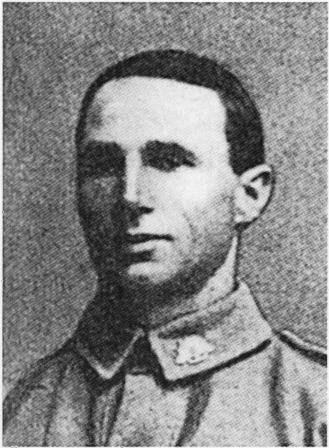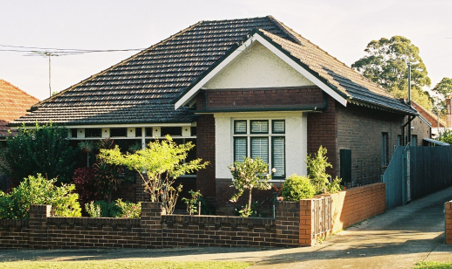
1882-1916
Spencer Edward MAXTED
Eyes brown, Hair brown, Complexion dark
Sydney Anglican Minister – son, brother, husband and father
In preparing this document, we acknowledge the story on Reverend Maxted published by the FFFAIF on 27 June 2008 on which it was originally based.
Born in June 1882, Spencer was one of five children of Henry, a clerk in the public service, and Alice Maxted. He was well-educated having begun his schooling at Cleveland Street Superior Public School and later earned a scholarship to Trinity College at the University of Melbourne. He attained his Bachelor of Arts in 1911, including winning a university prize for Hebrew during his studies.
After graduating, Spencer was ordained a deacon and priest and worked a while at St Kilda before returning to Sydney. He continued his studies to earn his Bachelor of Divinity through the University of London and, in 1913 aged just 30, he was appointed rector of St Oswald’s Anglican Church at Haberfield in Sydney’s inner west. January 1914 saw his marriage to 22-year-old Gertrude Olive Clark at St Clement’s in Marrickville.
With the outbreak of the war, 32-year-old Spencer was keen to enlist as a chaplain but spaces were limited in the Army Chaplains’ Department, so he enlisted instead as a private with the ambulance corps. The Argus reported on his Trinity College send-off noting that Spencer believed that:
“his service as a volunteer was in no way incompatible with his sacred calling, and that he was equally ready to shoulder a rifle or act as stretcher-bearer if required.”
Planning ahead, Spencer resigned his appointment at St Oswald’s as he intended to go to London after the war to complete his doctorate in divinity. Three days before Christmas 1914, Spencer left Melbourne for the Middle Eastern theatre of war leaving his newly pregnant wife at home in Sydney.
Middle East: Gallipoli, Mudros, Egypt - stretcher bearer and, finally, chaplain
Private Maxted arrived in Alexandria on 1 February 1915 and was promoted to Lance Corporal in March 1915. Throughout his time in the Middle East, he served with the field ambulance – presumably as a stretcher bearer conducting first aid and transporting wounded – and also with Divisional Headquarters at Port Mudros. Spencer also spent short periods in hospital for treatment for gastritis and for influenza.
With the evacuation of Gallipoli, Spencer arrived in Egypt in early January 1916 having been appointed as chaplain from 1 January 1916. He was assigned to hospital duty and worked with the 14th Brigade and at the Aerodrome camp at Heliopolis. On the first anniversary of the ANZAC landing (25 April 1916) he was officially attached to the 54th Battalion as their chaplain. He had achieved his goal!
From testimony of others, it appears that Spencer was dedicated to supporting the men of the 54th - some seasoned Gallipoli veterans like himself, and others newly arrived recruits from Australia – in whatever way he could as they trained in the gruelling heat and sand of Egypt.
From 3005 Corporal Victor F. Back, 54th Battalion:
He was a hero every inch of him. To show you what sort of a man he was, during a march in Egypt over the sand there was one bottle of water to each man. I know he gave his bottle to the other men and must have been famished himself.
The man all thought a great lot of him – he would come down into the lines at night sometimes – have a sing-song and sometimes hymns – just to help the boys. If ever there was a big march or anything he was there with the boys. Out in our front line somewhere in Arabia I think there were several out-posts and I’ve known him have an early service and tramp over some 5 or 6 miles to have service in another place and anyone in Egypt will know what that means.
Historian C.E.W Bean also noted that in the trying march of the 14th Brigade across the desert from Tel el Kebir, though entitled to ride, Maxted had walked with his battalion.
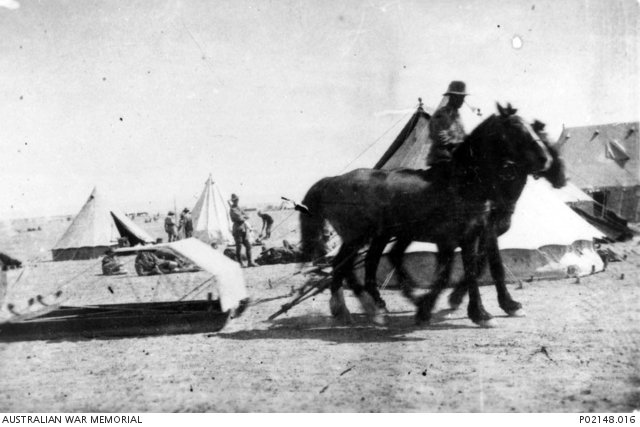
France: Padre Maxted – a grand man
In June, Spencer went with the 54th Battalion to France, headed for the trenches on the Western Front. He was with the Battalion when it went ‘over the top’ at the Battle of Fromelles.
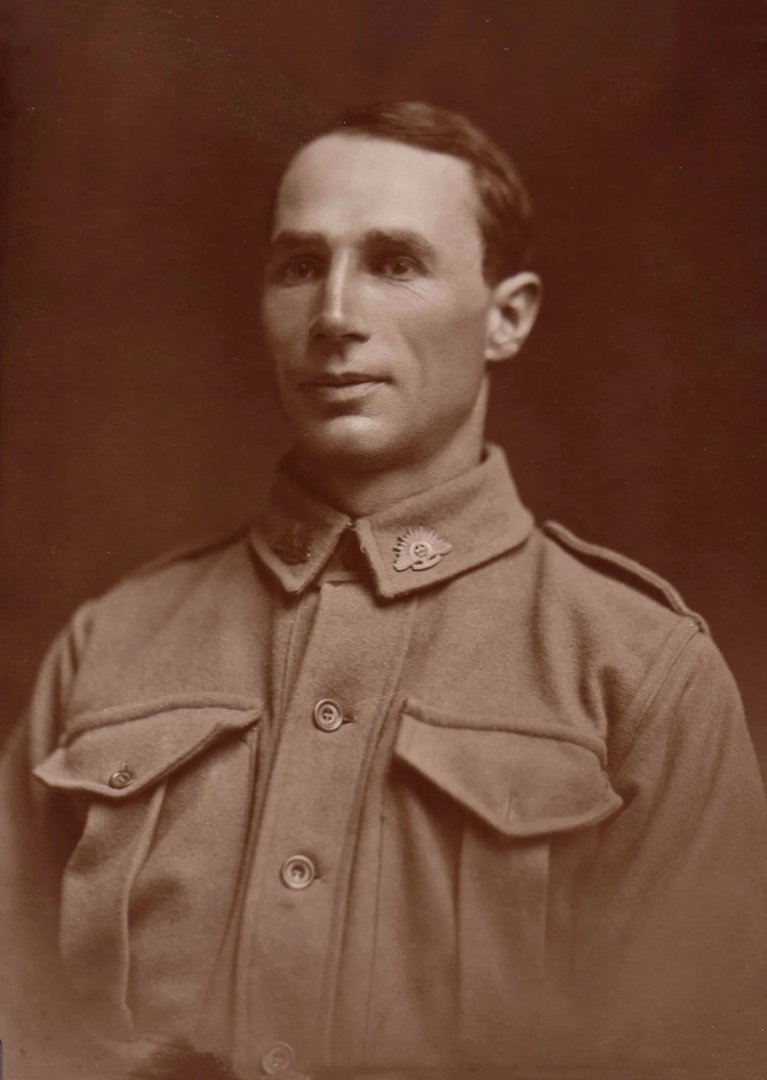
In an article by the FFFAIF (posted 27 June 2008), they quote a report by a local newspaper, The Haberfield Harbinger dated 24 October 1916:
A CHAPLAIN’S DEATH A war correspondent writing of the great battle which lasted from 6 am 19th July to 2 pm on the 20th says: During the fight we unfortunately lost one of our chaplains – Captain Rev. S.E. Maxted, M.A., B.D. Dog-tired with running for stretcher bearers during a fierce cannonade, he turned aside for refuge and rest into a trench, and sitting down in the corner he immediately fell asleep. It was a front-line trench, and by and by a high explosive landed on the parapet, a fragment killing him instantly. The loss is much mourned throughout the brigade. Originally he was an A.M.C. corporal, but after Gallipoli he was appointed a chaplain.”
There are a number of reports relating to Spencer’s death, some with conflicting details as you would expect with evidence given about a period of dreadful chaos and loss months after the battle – often by soldiers still recovering from their own injuries and shock. It was clear however that Chaplain Maxted was held in the highest regard and that he had offered his services wherever and however he could, and, as a trained medic, he was willing and able to tend the wounded.
The evidence given to the Red Cross enquiry generally agreed that Spencer was killed by shellfire on the evening of 19 July 1916. The men of the 54th Battalion attest to his expertise at bandaging and his willingness to be with the troops in the front line and to help where needed. Stories are told of him acting as stretcher bearer to move the wounded - often while under fire – providing water, giving up his own helmet to a young soldier who had lost his, and the like. Some of the soldiers characterised their padre as ‘plucky’, ‘a man among men’ and ‘a grand man’. Extracts from the evidence can be read below.
There was reference to Maxted’s exploits in the diary of a fellow padre, Frederick P Williams, M.C. who was attached to the 58th Battalion. Relevant extracts from his diary for July 19, 1916 and the days that followed include:
“Wednesday, July 19: "I came up to the Rouge de Bour dressing station just at the back of the lines where I was engaged the whole night administering hot drinks of beef tea to the wounded…….
…..It was seemingly a morning of desolation. Artillery duels were still going strongly as we commenced the task of bringing up the dead. In the afternoon, staff and I went down to the trenches. I found Chaplain Maxted (who would later be credited with helping 150 wounded away from the front line) at the end of Brompton Avenue all hunched up but quite dead. I attempted to straighten his body but was seen by the Bosch in the gap that had been blown in the trench and they turned their machine gun on me so I had to get out.
The wastage on the battlefield is terrific - men, guns, shells, our stores are littered everywhere.
….. Night fell with a silence as rare as profound and we obtained some much needed rest. We relieved at 9pm, utterly worn out."
Australian war correspondent and historian, Charles Bean, also makes specific mention of Maxted’s death:
“In the Australian trenches the scene was such that General Tivey, who, always solicitous for his men, had hurried thither on hearing of the retirement, could not hold back his tears. In spite of the clearance of wounded during the night by motor-ambulances working as far forward as the usual battalion headquarters, the front line was now peopled with wounded and dying, among whom Chaplain Maxted, working in his shirt-sleeves and without puttees, rendered, until he was killed, services of mercy never to be forgotten by those who benefited by them.”
The Army’s Court of Enquiry found that Captain Chaplain Maxted was killed in action on 19/20 July 1916. He was buried in the Rue-Petillon Military Cemetery near Fleurbaix together with more than 100 other Australian soldiers killed in the Battle of Fromelles. His gravestone bears the inscription “A true servant of Jesus Christ.”

Nearly a century later, Maxted’s grave in this French war cemetery where many of the 54th Battalion are buried, played a small but inspirational part in Lambis Englezos’ struggle to have the soldiers buried at Fromelles identified and honoured for their sacrifice. Patrick Lindsay in his book Fromelles (2008, pages 335-336) described Lambis’ visit in mid-2007 just as the initial exploration of the mass grave site had begun. Understandably, the uncertainty of waiting for outcomes from the official investigation was a time of emotional turmoil for Lambis filled with hope, fear and all the emotional ‘what ifs’ that can plague even the truest of believers. This day, he found solace in walking through the Rue-Petillon cemetery reading the headstones, finally stopping to rest from the heat in front of the headstone of one of his favourite characters of the battle - the Reverend Spencer Maxted, the beloved chaplain of the 54th Battalion. Lambis found himself in conversation with Maxted seeking his counsel:
“I was quite emotional. I may have been dazed by the heat, but I felt very comfortable there. I felt he gave me his blessing.”

It may be that the chaplain was continuing his ministry for “his boys” by helping in whatever way he could.
Family back in Australia
On 6 June 1915, Gertrude gave birth to twin girls – Gertrude Elizabeth (known as Beth) and Alice Ruth. At this time, Spencer was in the Middle East and it would have been some time before he received news of his daughters’ safe arrival. Sadly, the three were never to meet as just fourteen months later, Gertrude was advised of Spencer’s death.
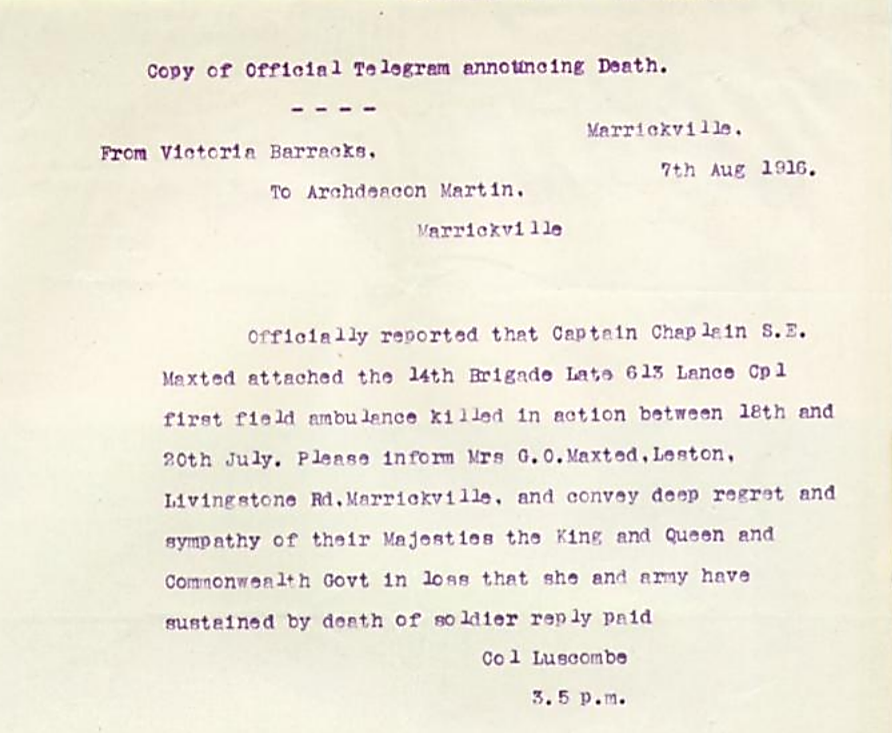
When Spencer’s personal effects were returned to Gertrude as next of kin, it included various letters, postcards and photos as well as other items of kit. It is hoped that those photos may have included images of his baby daughters so he might at least have known what they looked like as well as reading in letters how they were growing while he was so far away. We can but hope and imagine.
As a young widow, Gertrude lived with her widowed mother (Lizzie Clark 1866-1942), originally at Marrickville and Turramurra and later at Pymble. While the twin girls never met their father, both added Spencer as a third Christian name in his honour. Coincidentally, Beth happened to also marry a man with the surname Spencer.
Not a lot is known of the family’s life after Spencer’s death. The army awarded a pension for Gertrude and her daughters and also for Spencer’s mother, Alice Maxted. With Spencer’s death, Alice had lost the third of her five children as well as her husband. Another son, Henry, died in 1919.
Indications are evident that Gertrude had the support of her own family, the Clarks, but again details are limited. Until her mother’s death in 1942 she was living with her widowed mother and younger sister, Bessie. Her father, Theodore Clark had been a director of Marcus Clark & Co, the successful department store founded in 1883 by Theodore’s older brother, Henry Marcus Clark (1859-1913). After Henry Marcus’ death, his son, Reginald Marcus Clark (both father and son went by the name, Marcus Clark), took over the reins and the business remained under Clark family management until taken over by Waltons in 1966. Theodore himself had died tragically in 1908 aged 42 after falling down a lift shaft in the store’s landmark flat iron building on the corner of George and Pitt Streets.
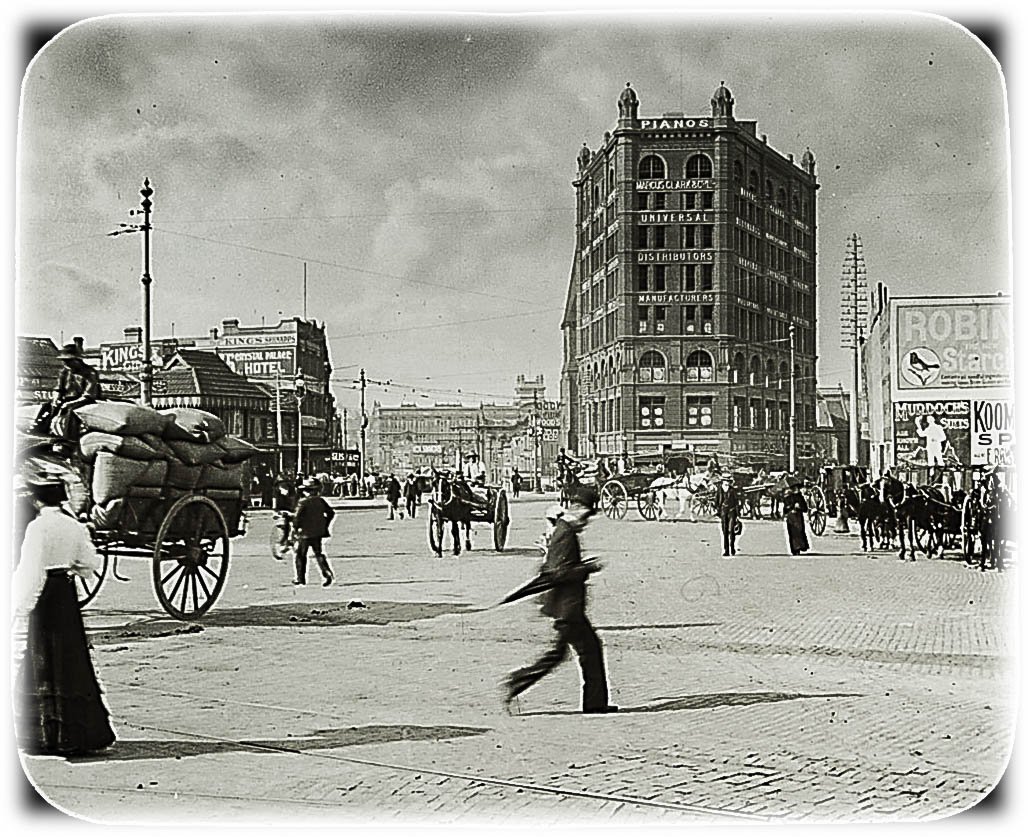
In addition to the death of son-in-law, Spencer Maxted, Gertrude’s immediate family paid a high price during the War with one son wounded and two sons killed in action.
Lieutenant William Frederick CLARK 1893-1918
Draper, served with the 55th Battalion and was killed on 17 April 1918 at Villers-Brettonneux. He was awarded the Military Cross for conspicuous gallantry and devotion to duty during the attack at Polygon Wood in September 1917. He is buried at the Aubigny British Cemetery, France and was married with one son.
7392 Gunner Roy Marcus CLARK 1898-1918
A motor mechanic, enlisted at 18 and served with the 2nd Field Artillery Brigade. He was killed in action on 19 September 1918 and is buried in Hancourt British Cemetery near Peronne in France.
4487 Private Cuthbert Theodore CLARK 1895-1953
Enlisted in April 1915 and was an original member of the 3rd Australian General Hospital serving at Lemnos and Egypt. It is possible that Cuthbert and his brother-in-law Spencer Maxted crossed paths during this time. In June 1916, Cuthbert transferred to the 54th Battalion where Spencer was serving as chaplain. Cuthbert was wounded at Fromelles on 17 July 1916 and was evacuated to England and so did not fight in the actual Battle of Fromelles. He returned to Australia in February 1917 and completed studies to become a chartered accountant. Cuthbert married and raised a family - including a son named John Spencer Clark, presumably in honour of his brother-in-law.
Gertrude’s youngest brother, born in 1904, was Raymond Anthony CLARK, but known as Tony. He was too young for the Great War but served in World War II with 2/2 Australian Field Ambulance where he was mentioned in despatches. NX6356 Lieutenant R. A. Clark was taken prisoner of war in Greece in 1941 and served the remainder of the war in Stalag VIIIB in Germany before eventually returning home to his family.
Gertrude had another sibling, Bessie Southee Clark 1903-1999 - who did not marry.
Gertrude herself never remarried and lived till the age of 92 years, by then a dearly loved mother, grandmother and great-grandmother.
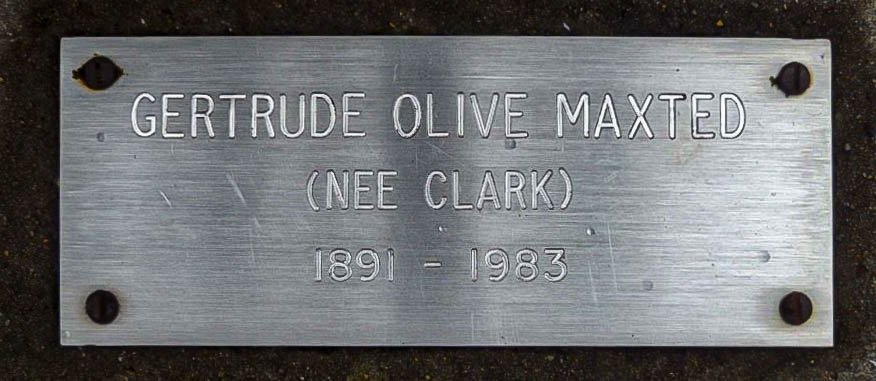
Evidence given to the Red Cross regarding Chaplain Spencer E. Maxted
Source: AWM: Australian Red Cross Wounded and Missing Files – Spencer Edward MAXTED – pages as noted.
All the soldiers who provided evidence were from the 54th Battalion and, at the time of giving evidence, were hospitalised as they recovered from wounds received on the Western Front, mostly at Fromelles.
From 3041 Private John G. Ellis:
“(Maxted) was blown to bits when helping to bandage some of the wounded at Fleurbaix. He might not have been so good in the pulpit but my word, he was the gamest man in the 54th. He just hopped over the trenches with the rest when the charge was on and said “there are going to be a lot of casualties, and I’ll help you all I can.” I told him to look out and be careful, but he said “We will all be wanted today.” “My word”, he said “our boys are brave”. He was very clever bandaging and while he was busy was blown to bits. He was plucky”.
From 3005 Corporal Victor F. Back:
“In France he was always down in the front line with the boys, and he need not have been. The night of the big attack at Fleurbaix he was first over the parapet with the stretcher-bearers. We had to go about 200 yards and the firing was so hot we were obliged to lie down for some ten minutes and (sic) till our artillery fire lifted. Not so Capt. Maxted, he was getting about amongst the wounded lads, bandaging and my word, he knew how to do it too. – carrying wounded and giving water to others. The Machine gun and artillery fire was hot at this time he must simply have led a charmed life. One thing – someone said Capt. Hanson was wounded and he went through a perfect hail of fire with his bandages and water bottle. If ever any man deserved anything, it was Capt. Maxted, he simply did not know what fear was. He was calmly walking about under heavy fire bandaging and helping wounded men. He was bandaging a wounded man when he was killed. He was a man among men.”
From 4603 Private Laurence Sullivan :
“On July 19th 1916 at Fromelles he saw the Chaplain Capt. Maxted and Father Kennedy, the R.C. Chaplain acting as stretcher bearers.”
Note Kennedy, the chaplain attached to the 53rd Battalion, was awarded the DSO for his work that night.
From Lieutenant Reginald S. Healy:
“He was sitting on the fire step and a man came along without a helmet and he said ‘take my steel helmet’. That man was killed and Padre Maxted put on another helmet. He fell asleep on the firestep and was killed in his sleep at 5.30 p.m. I saw him killed.”
From 4181 Charles T.A. Horder:
“…on July 19th near Fromelles Capt. C.S.E. Maxted was killed. He was doing Red Cross work. His head was blown clean off. He was a Clergyman. He had previously given his helmet to E. H. B. Williams.”
Note The Pte Williams mentioned is believed to be 4911 Private Edward Henry Blunt Williams (4911), then aged 19 years. He survived the war and lived into his 70s.
From 3654 Private Thomas R. Quinn :
“He was Battn chaplain, and was killed on the night of July 19-20th in the front trenches at Fromelles, while helping to get wounded away after an attack which took place at 6 p.m.”
From 3122 Sergeant John Pitt :
“He was Chaplain. Before the advance he was in the front line at Fromelles and I saw him blown to pieces by a shell.”
From 3471 Corporal George P. Brown :
“At Fleurbaix, in the trenches, before we went out, he was practically blown to pieces by a shell in the afternoon between 5 and 6 p.m on 19th. I was speaking to him about half an hour before. He was a grand man – was always helping the wounded – in fact he was attending to someone when the shell burst just behind him.”
From 4928 Private Norman Uhr :
“It was on 19th July about 10p.m. in No Man’s Land. Witness was lying wounded in a shell hole and spoke to deceased, who was a few yards from him. Deceased was killed instantaneously; his head was knocked about by a shell.”
The Fromelles Association would love to hear from you

Contacts
(Contact: royce@fromelles.info or geoffrey@fromelles.info).
(Contact: army.uwc@defence.gov.au or phone 1800 019 090).
Donations
If you are able, please contribute to the upkeep of this resource.
(Contact: bill@fromelles.info ).
